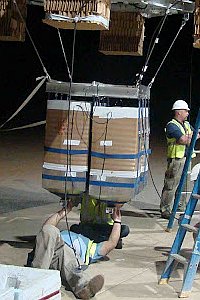 Ballast
Ballast

In ballooning, the term ballast refers to any material which acts as a stabilizer and provides a means of controlling the rate of gain of rise as well as the altitude.
Originally, the ballast used on the first manned ascension were sand bags tied to the border of the basket or gondola that were cut and released when necessary. Also, unused parts of gear like depleted batteries or other hardware were often used as height stabilizers. Generally they were attached with small parachutes to prevent damages on ground.
With the advent of the plastic balloon and the beginning of the unmanned flights era, were developed several systems to release ballast automaticaly when a critical altitude was reached by the balloon in flight. Early systems included the use of dispensers of kerosen or other liquids as ballast, but often they iced as the balloon passed by the tropopause, the coldest layer of the atmosphere. Also the danger of the spill of a flammable liquid at landing discontinued their use.
That would lead to a more sophisticated ballast system that uses fine steel or iron pellets inside. The ballast hopper is usually built of cardbord in the form of a rectangular box (like the one shown in the picture at left) with an inverted pyramid shaped bottom opening into a round port. The port is open to ballast flow; however, the presence of a permanent magnet at the port causes the steel pellets to cluster together and prevent the flow. To allow the ballast to flow, an electromagnet is energized to oppose the permanent magnetic field. This action, called ballasting, may be done by command or by a timer.
In other cases on which the presence of a large mass of iron or steel under the gondola can affect the behaviour of an onboard balloon experiment, small pellets of glass or sand are used instead and controled by telemetry by a non magnetic system.
The amount of ballast carried in each flight is a function of the total weight transported and varies between 6 and 10 percent of it.

